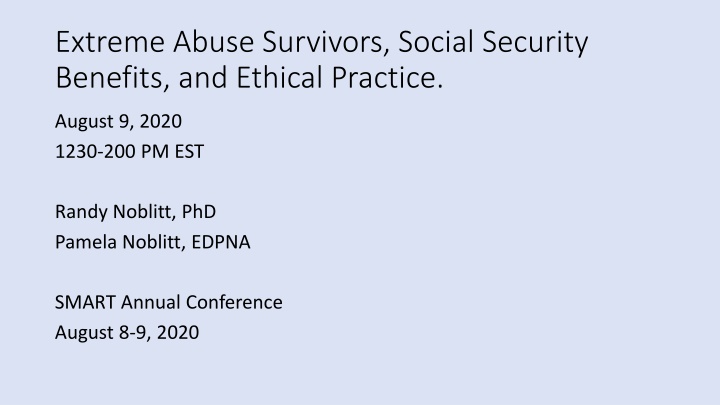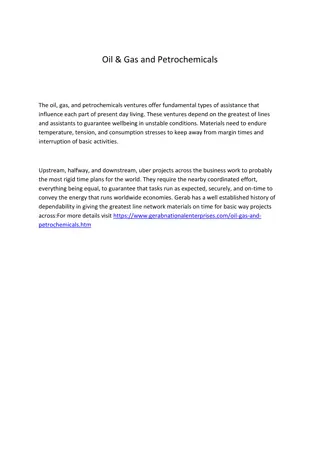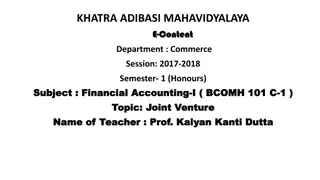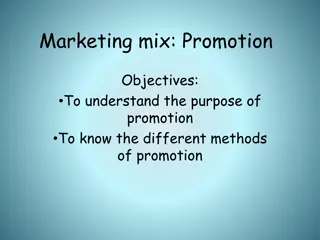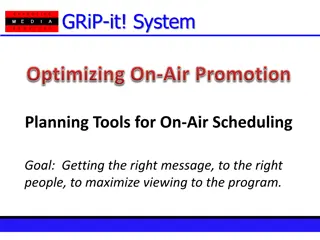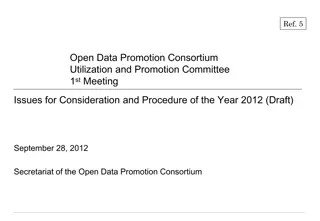Effective Promotion Strategies for New Ventures
Learn how to promote products/services effectively for a new venture by utilizing various marketing techniques such as personal selling and sales promotions. Explore cost-effective ways to reach customers and enhance brand visibility in the market.
Download Presentation

Please find below an Image/Link to download the presentation.
The content on the website is provided AS IS for your information and personal use only. It may not be sold, licensed, or shared on other websites without obtaining consent from the author.If you encounter any issues during the download, it is possible that the publisher has removed the file from their server.
You are allowed to download the files provided on this website for personal or commercial use, subject to the condition that they are used lawfully. All files are the property of their respective owners.
The content on the website is provided AS IS for your information and personal use only. It may not be sold, licensed, or shared on other websites without obtaining consent from the author.
E N D
Presentation Transcript
Extreme Abuse Survivors, Social Security Benefits, and Ethical Practice. August 9, 2020 1230-200 PM EST Randy Noblitt, PhD Pamela Noblitt, EDPNA SMART Annual Conference August 8-9, 2020
General healthcare ethics What can we say about it? First do no harm.
American Psychological Association (2017). Ethical principles of psychologists and code of conduct. https://www.apa.org/ethics/code/
APA (2017) Ethics Code General Principles Principle A: Beneficence and Nonmaleficence Principle B: Fidelity and Responsibility Principle C: Integrity Principle D: Justice Principle E: Respect for People s Rights and Dignity
APA (2017) Ethical Standards How are they different from ethical principles? Are there any that we should especially consider in the care of PWDs?
Law ADA SSA
What is ADA? Is the ADA definition of disability the same, or different with respect to the SSA definition? In what ways do the ADA and SSA laws serve PWDs?
Most SSA applicants are not approved. One of the most common reasons for non-approval is that their treating professionals do not adequately evaluate and document their health conditions and capacity for working. The SSA uses diagnoses similarly to medicine and professional psychology, however their criteria for disability require thorough, precise, evaluations that are conceptually coherent and credible.
What Is Disability? The SSA defines disability as a medically determinable physical or mental impairment that is so severe it prevents an individual from engaging in full-time work in a competitive work setting at any job within the national economy (Noblitt & Noblitt, 2020, p . 9).
Psychological and Medical Diagnoses vs. SSA criteria: Listing of Impairments (Adults) Listing of Impairments (Adults) Listing of Impairments (Children)
Listing of Impairments (Adults, continued) 1.00 Musculoskeletal System (see Appendix A, 1.00), 2.00 Special Senses and Speech (see Appendix A, 2.00), 3.00 Respiratory Disorders (see Appendix A, 3.00), 4.00 Cardiovascular System (see Appendix A, 4.00), 5.00 Digestive System (see Appendix A, 5.00), 6.00 Genitourinary Disorders (see Appendix A, 6.00), 7.00 Hematological Disorders (see Appendix A, 7.00), 8.00 Skin Disorders (see Appendix A, 8.00),
Listing of Impairments (Adults, continued) 9.00 Endocrine Disorders (see Appendix A, 9.00), 10.00 Congenital Disorders That Affect Multiple Body Systems (see Appendix A, 10.00), 11.00 Neurological Disorders (see Appendix A, 11.00), 12.00 Mental Disorders (see Appendix A, 12.00), 13.00 Cancer (Malignant Neoplastic Diseases, see Appendix A, 13.00), and 14.00 Immune System Disorders (see Appendix A, 14.00).
Listing of Impairments (Child) 100.00 Low Birth Weight and Failure to Thrive (see Appendix B, 100.00), 101.00 Musculoskeletal System (see Appendix B, 101.00), 102.00 Special Senses and Speech (see Appendix B, 102.00), 103.00 Respiratory Disorders (see Appendix B, 103.00), 104.00 Cardiovascular System (see Appendix B, 104.00), 105.00 Digestive System (see Appendix B, 105.00), 106.00 Genitourinary Disorders (see Appendix B, 106.00),
Listing of Impairments (Child, continued) 107.00 Hematological Disorders (see Appendix B, 107.00), 108.00 Skin Disorders (see Appendix B, 108.00), 109.00 Endocrine Disorders (see Appendix B, 109.00), 110.00 Congenital Disorders That Affect Multiple Body Systems (see Appendix B, 110.00), 111.00 Neurological Disorders (see Appendix B, 111.00), 112.00 Mental Disorders (see Appendix B, 112.00), 113.00 Cancer (Malignant Neoplastic Diseases, see Appendix B, 113.00), and 114.00 Immune System Disorders (see Appendix B, 114.00).
What Is Work? Work consists of combined mental effort and physical exertion resulting in an intellectual or tangible product (N&N, 2020, p. 12).
Clinical Assessment of the Ability to Work Residual functional capacity (RFC) A subjective assessment of the claimant s ability to perform typical work activities despite physical or mental limitations due to illness or injury (N&N, 2020, p. 537). Mental RFC Same as the above, but psychological
Mental residual functional capacity (MRFC) The SSA s four general categories of MRFC include the ability to (1) understand, remember, or apply information; (2) interact with others; (3) concentrate, persist, or maintain pace; and (4) adapt or manage oneself. (N&N, 2020, p. 20).
SSA subdivides mental residual functional capacity (MRFC) into these 20 subcategories: A. Understanding and Memory 1. The ability to remember locations and work-like procedures 2. The ability to understand and remember very short and simple instructions 3. The ability to understand and remember detailed instructions
Mental residual functional capacity (MRFC) B. Sustained Concentration and Persistence 4. The ability to carry out very short and simple instructions 5. The ability to carry out detailed instructions 6. The ability to maintain attention and concentration for extended periods 7. The ability to perform activities within a schedule, maintain regular attendance, and be punctual within customary tolerances 8. The ability to sustain an ordinary routine without special supervision 9. The ability to work in coordination with or proximity to others without being distracted by them 10. The ability to make simple work-related decisions 11. The ability to complete a normal workday and workweek without interruptions from psychologically based symptoms and to perform at a consistent pace without an unreasonable number and length of rest periods
Mental residual functional capacity (MRFC) C. Social Interaction 12. The ability to interact appropriately with the general public 13. The ability to ask simple questions or request assistance 14. The ability to accept instructions and respond appropriately to criticism from supervisors 15. The ability to get along with coworkers or peers without distracting them or exhibiting behavioral extremes 16. The ability to maintain socially appropriate behavior and to adhere to basic standards of neatness and cleanliness
Mental residual functional capacity (MRFC) D. Adaptation 17. The ability to respond appropriately to changes in the work setting 18. The ability to be aware of normal hazards and take appropriate precautions 19. The ability to travel in unfamiliar places or use public transportation 20. The ability to set realistic goals or make plans independently of others
Disability Determination The determination of disability can only be conferred by the commissioner of the SSA or the commissioner s designees, including Social Security field offices, state Disability Determination Services, administrative law judges, the Appeals Council, or federal courts. Clinicians opinions that a patient is disabled are not accorded any weight by Social Security in the disability determination process because clinicians definitions of disability are generally incompatible with that of the SSA (Noblitt & Noblitt, 2020, p. 18).
Disability Determination: Measuring Disability Treating clinicians opinions can influence the disability determination process if their treatment records support their assessment of exertional or nonexertional limitations resulting from their patient s condition and treatment. The opinion of the treating physician is not accorded any greater weight than the opinion of nontreating or examining-only clinicians unless treatment records are supportive of the doctor s opinion (Noblitt & Noblitt, 2020, p. 18).
Measuring Disability However, if the treating clinicians treatment records support their professional opinions and the Administration s contracted examining or nonexamining clinical opinions result in substantially different conclusions, the Administration or administrative law judge is more likely to find the examining or nonexamining professionals opinions less credible and give the treating source greater influence in disability determination (Noblitt & Noblitt, 2020, p. 18).
Measuring Disability Clinicians should consider recording progress notes that identify the patient s job and describing any physical and mental limitations experienced as a result of injury, illness, or mental impairment. This note-keeping process would not only provide valuable information for insurers, agencies, and adjunctive health-care services that may be prescribed but would also benefit claimants by providing concrete examples of the effect of signs and symptoms of possible medically determinable impairments (MDIs) (Noblitt & Noblitt, 2020, p. 19).
Diagnoses, Symptoms, and Limitations in the Assessment of Disability Diagnoses of severe medical or psychological conditions with their attendant symptoms and adverse effects of treatment may be considered disabling by clinicians, but treatment records often do not reflect the seriousness of the claimants disabilities because, as a general rule, clinicians do not equate symptoms and the effects of treatment with functional limitations (Noblitt & Noblitt, 2020, pp. 26-27).
Contributing Factors in Disability Determination The Administration considers other factors in addition to the severity of the claimant s impairments and functionality. These factors include age, obesity, education level, transferability of skills, and English fluency (N&N, 2020, p. 27).
Psychological Disabilities: Adult Listings 12.02 Neurocognitive disorders (see Appendix A, 12.02); 12.03 Schizophrenia spectrum and other psychotic disorders (see Appendix A, 12.03); 12.04 Depressive, bipolar, and related disorders (see Appendix A, 12.04); 12.05 Intellectual disorder (see Appendix A, 12.05); 12.06 Anxiety and obsessive-compulsive disorders (see Appendix A, 12.06);
Psychological Disabilities: Adult Listings 12.07 Somatic symptom and related disorders (see Appendix A, 12.07); 12.08 Personality and impulse-control disorders (see Appendix A, 12.08); 12.10 Autism spectrum disorder (see Appendix A, 12.10); 12.11 Neurodevelopmental disorders (see Appendix A, 12.11); 12.13 Eating disorders (see Appendix A, 12.13); and 12.15 Trauma- and stressor-related disorders (see Appendix A, 12.15).1
Psychological Disabilities: Child Listings 112.02 Neurocognitive disorders (see Appendix A, 112.02); 112.03 Schizophrenia spectrum and other psychotic disorders (see Appendix A, 112.03); 112.04 Depressive, bipolar, and related disorders (see Appendix A, 112.04); 112.05 Intellectual disorder (see Appendix A, 112.05); 112.06 Anxiety and obsessive-compulsive disorders (see Appendix A, 112.06); 112.07 Somatic symptom and related disorders (see Appendix A, 112.07);
Psychological Disabilities: Child Listings 112.08 Personality and impulse-control disorders (see Appendix A, 112.08); 112.10 Autism spectrum disorder (see Appendix A, 112.10); 112.11 Neurodevelopmental disorders (see Appendix A, 112.11); 112.13 Eating disorders (see Appendix A, 112.13); 112.14 Developmental disorders in infants and toddlers (see Appendix A, 112.14); and 112.15 Trauma- and stressor-related disorders (see Appendix A, 112.15).
SSAs revised child and adult Listings of Mental Impairments are closer in similarity to the DSM-5 categories than previously, they are still not identical (N&N, 2020, p. 59). The DSM-5 also lists an additional category, medication-induced movement disorders and other adverse effects of medication, that is not considered a mental disorder but is nonetheless important to assess and track (p. 59).
Methods of Psychological Information Gathering?
Methods of Psychological Information Gathering? Review of Records
Methods of Psychological Information Gathering? Review of Records Psychological Testing
Methods of Psychological Information Gathering? Review of Records Psychological Testing Interviewing Mental Status Exam History
This is the textbook for the last four classes
An Overview of SSD Programs The two main SSA programs that are important to clinicians and their patients: Social Security Disability Insurance (SSDI) Supplemental Security Income (SSI)
An Overview of Social Security Disability Programs: SSDI Social Security Disability Insurance (SSDI) provides the following benefits: Monthly income based on a complicated formula using the claimant s earnings record for the prior 15 years. Back-due benefits based on the monthly payment the claimant would have received had benefits been awarded at the time of application. Medicare eligibility 29 months from the claimant s alleged onset date. SSDI beneficiaries receive Medicare part A (hospitalization) at no cost but medicare parts Bprovider) and D (prescriptions) has a premium deducted monthly from the SSDI payment.
An Overview of Social Security Disability Programs: SSI Supplemental Security Income (SSI) provides the following benefits: Monthly income based on the federal benefit rate (FBR) for 2020 of $783 for an eligible individual and $1,175 for a couple. Back-due benefits based on the monthly payment the claimant would have received had benefits been awarded at the time of application. Medicaid (or state s equivalent) available immediately upon approval of SSI claim.
An Overview of Social Security Disability Programs SSDI claimants whose benefit is very low may also be entitled to SSI and receive both Medicare and Medicaid. A program, Qualified Medicare Beneficiary (QMB) may be applicable. QMB pays the beneficiary s premium and co-pays so the claimant receives more cash. SSI is available to disabled children and to adults over the age of 65.
An Overview of Social Security Disability Programs: SSDI Eligibility Social Security Disability Insurance eligibility Paid social security taxes for sufficient quarters during the past 15 years prior to disability Not engaged in full-time competitive work since onset of disabling condition Have severe impairment that has lasted or is expected to last 12 months or result in death Physical or mental limitations preventing return to past relevant work (work performed during proceeding 15 years) Limitations preventing any other work in national economy
An Overview of Social Security Disability Programs: SSI Eligibility Supplemental Security Income Eligibility Not engaged in full-time competitive work since onset of disabling condition Have severe impairment that has lasted or is expected to last 12 months or result in death Physical or mental limitations preventing return to past relevant work (work performed during proceeding 15 years) Limitations preventing any other work in national economy Meeting SSI financial criteria (See Noblitt & Noblitt, 2020)
What is disability according to The Social Security Administration? The SSA defines disability as a medically determinable physical or mental impairment that is so severe it prevents an individual from engaging in full-time work in a competitive work setting at any job within the national economy, and where payment for such employment will average at least $1260 substantial gainful activity (SGA) for non-blind individuals in 2020. For blind individuals, the SGA is $2,110.
This definition is foundational in Social Security disability determination. Impairments that significantly limit an individual s strength, endurance, mobility, intelligence, cognition, concentration, attention, persistence, and pace of performance would affect that person s ability to perform any work. Furthermore, Social Security s definition of disability requires that the impairment must have lasted or be expected to last at least 12 months or result in death.
How is disability defined for children? Since most children do not work, the impact of their severe physical or mental impairments is considered relative to school performance at grade or age level, behavioral and social adaptation, and meeting developmental milestones appropriately and timely.
How is disability proven? Kinds of evidence (Stretton, 2017 cited in Noblitt & Noblitt, 2020) Objective Subjective Opinion
Objective evidence Objective medical evidence is medical evidence that can be verified by other healthcare professionals using medically acceptable clinical or laboratory techniques Stretton, 2017, p. 7). Includes objective psychological testing and description of clinical signs.
Subjective evidence The subjective statements of the claimant.
Opinion Evidence Opinions by Acceptable Medical Sources (psychologists are included with physicians). Opinions by examining acceptable treating sources (consultative examiner and independent or qualified medical examiner) Opinions by non-examining acceptable treating sources (medical expert , social security, and department or disability determination)
